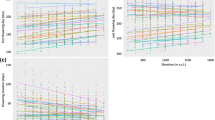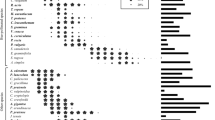Abstract
Flowering timing is of fundamental biological importance for its tight association with pre-flower growth states and subsequent reproduction success. Here, we selected plant height and seed size to represent plant growth and reproduction states, respectively, and analyzed their associations with flowering time in 11 communities together representing a QingHai-Tibetan flora. Trait associations were examined using Pearson correlation analyses (TIPs) and phylogenetically independent contrasts (PICs) within individual communities and meta-analyses across all communities. The results of TIPs-based and PICs-based analyses were generally congruent, although fewer contrasts were significant with PICs, probably because of low statistical power. Overall, flowering time was negatively correlated with seed size and plant height (i.e., plants with larger seeds and stature started flowering earlier) in various woody communities, but correlations were neutral or positive in herbaceous communities. The seed size–flowering time relationship was negative for woody and herbaceous perennials but not for annual herbs in most communities. The relationship between plant height and flowering time was negative for woody but positive for herbaceous plants. Moreover, the lack of difference in time–size relationships between anemophilous and entomophilous plants suggests that pollination type may only be a secondary force in controlling flowering phenology. Our studies demonstrate that environmental conditions, community structure, and plant life history strategies may affect community flowering time singly or in combination.




Similar content being viewed by others
References
Bolmgren K, Cowan PD (2008) Time–size tradeoffs: a phylogenetic comparative study of flowering time, plant height and seed mass in a north-temperature flora. Oikos 117:424–429
Bolmgren K, Eriksson O, Linder HP (2003) Contrasting flowering phenology and species richness in abiotically and biotically pollinated angiosperms. Evolution 57:2001–2011
Cenci CA, Ceschia M (2000) Forecasting of the flowering time for wild species observed at Guidonia, central Italy. Int J Biometeorol 44:88–96
Coomes DA, Grubb PJ (2003) Colonization, tolerance, competition and seed–size variation within functional groups. Trends Ecol Evol 18:283–291
Cornelissen JHC, Lavorel S, Garniel E, Díaz S, Buchmann N, Gurvich DE et al (2003) A handbook of protocols for standardised and easy measurement of plant functional traits worldwide. Aust J Bot 51:335–380
Dahlgren JP, von Zeipel H, Ehrlén J (2007) Variation in vegetative and flowering phenology in a forest herb caused by environmental heterogeneity. Am J Bot 94:1570–1576
Fabbro T, Körner Ch (2004) Altitudinal differences in flower traits and reproductive allocation. Flora 199:70–81
Felsenstein J (1985) Phylogenies and the comparative method. Am Nat 125:1–15
Gadgil M, Solbrig OT (1972) The concept of r- and K-selection: evidence from wild flowers and some theoretical considerations. Am Nat 106:14–31
Galloway LF (2002) The effect of maternal phenology on offspring characters in the herbaceous plant Campanula americana. J Ecol 90:851–858
Giménez-Benavides L, Escudero A, Iriondo JM (2007) Reproductive limits of a late-flowering high-mountain Mediterranean plant along an elevational climate gradient. New Phytol 173:367–382
Golluscio RA, Oesterheld M, Aguiar MR (2005) Relationship between phenology and life form: a test with 25 Patagonian species. Ecography 28:273–282
Grime JP (2001) Plant strategies, vegetation processes and ecosystem properties, 2nd edn. Wiley, Chichester
Gurevitch J, Curtis PS, Jones MH (2001) Meta-analysis in ecology. Adv Ecol Res 32:199–247
Hewitt N (1998) Seed size and shade-tolerance: a comparative analysis of North American temperate trees. Oecologia 114:432–440
Hyatt LA, Rosenberg MS, Howard TG, Fang W, Anastasia J, Brown K, Grella R, Hinman K, Kurdziel J, Gurevitch J (2003) The distance dependence prediction of the Janzen-Connell hypothesis: a meta-analysis. Oikos 103:590–602
Kitajima K (2002) Do shade-tolerant tropical tree seedlings depend longer on seed reserves? Functional growth analysis of three Bignoniaceae species. Funct Ecol 16:433–444
Knight TM, Steets JA, Vamosi JC, Mazer SJ, Burd M, Campbell DR, Dudash MR, Johnston MO, Mitchell RJ, Ashman TL (2005) Pollen limitation of plant reproduction: pattern and process. Annu Rev Ecol Evol Syst 36:467–497
Kochmer JP, Handel SN (1986) Constraints and competition in the evolution of flowering phenology. Ecol Monogr 56:303–325
Körner Ch (2003) Alpine plant life, 2nd edn. Springer, Berlin
Kudo G, Ida TY, Tani T (2008) Linkages between phenology, pollination, photosynthesis, and reproduction in deciduous forest understory plants. Ecology 89:321–331
Lusk CH, Warton DI (2008) Global meta-analysis shows that relationships of leaf mass per area with species shade tolerance depend on leaf habit and ontogeny. New Phytol 176:764–774
Mazer SJ (1990) Seed mass of Indiana dune genera and families: taxonomic and ecological correlates. Evol Ecol 4:326–357
McIntosh ME (2002) Flowering phenology and reproductive output in two sister species of Ferocactus (Cactaceae). Plant Ecol 159:1–13
Michalski SG, Durka W (2007) Synchronous pulsed flowering: analysis of the flowering phenology in Juncus (Juncaceae). Ann Bot 100:1271–1285
Milla R, Giménez-Benavides L, Escudero A, Reich PB (2008) Intra- and interspecific performance in growth and reproduction increase with altitude: a case study with two Saxifraga species from northern Spain. Funct Ecol 23:111–118
Miller-Rushing AJ, Primack RB (2008) Global warming and flowering times in Thoreau’s concord: a community perspective. Ecology 89:332–341
Molau U, Nordenhall U, Eriksen B (2005) Onset of flowering and climate variability in an alpine landscape: a 10-year study from Swedish Lapland. Am J Bot 92:422–431
Moles AT, Westoby M (2003) Latitude, seed predation and seed mass. J Biogeogr 30:105–128
Moles AT, Westoby M (2006) Seed size and plant strategy across the whole life cycle. Oikos 113:91–105
Murray BR, Kelaher BP, Hose GC, Figueira WF (2005) A meta-analysis of the interspecific relationship between seed size and plant abundance within local communities. Oikos 110:191–194
Ollerton J, Diaz A (1999) Evidence for stabilizing selection acting on flowering time in Arum maculatum (Araceae): the influence of phylogeny on adaptation. Oecologia 119:340–348
Ollerton J, Lack AJ (1998) Relationships between flowering phenology, plant size and reproductive success in Lotus corniculatus (Fabaceae). Plant Ecol 139:35–47
Pianka ER (1970) On r- and k-selection. Am Nat 104:592–597
Pluess AR, Schütz W, Stöcklin J (2005) Seed weight increases with altitude in the Swiss Alps between related species but not among populations of individual species. Oecologia 144:55–61
Preston K (1998) The effects of developmental stage and source leaf position on integration and sectorial patterns of carbohydrate movement in an annual plant, Perilla frutescens (Lamiaceae). Am J Bot 85:1695–1703
Primack RB (1985) Patterns of flowering phenology on communities, populations, individuals, and single flowers. In: White J (ed) The population structure of vegetation. Dr W. Junk Publishers, Dordrecht, pp 571–593
Ramirez N (2002) Reproductive phenology, life-forms, and habitats of the Venezuelan. Am J Bot 89:836–842
Read J, Sanson GD, Jaffré T, Burd M (2006) Does tree size influence timing of flowering in Cerberiopsis candelabra (Apocynaceae), a long-lived monocarpic rain-forest tree? J Trop Ecol 22:621–629
Roff DA (2002) Life history evolution. Sinauer, Sunderland
Rosenberg MS, Adams DC, Gurevitch J (2000) MetaWin: statistical software for meta-analysis, version 2.0. Sinauer Associates. Sunderland
Roux F, Touzet P, Cuguen J, Le Corre V (2006) How to be early flowering: an evolutionary perspective. Trends Plant Sci 11:375–381
Rowe NP, Speck T (2005) Plant growth forms: an ecological and evolutionary perspective. New Phytol 166:61–72
Schemske DW, Willson MF, Melampy MN, Miller LJ, Verner L, Schemske KM, Best LB (1978) Flowering ecology of some spring woodland herbs. Ecology 59:351–366
Singh KP, Kushwaha CP (2006) Diversity of flowering and fruiting phenology of trees in a tropical deciduous forest in India. Ann Bot 97:265–276
SPSS Inc (2006) SPSS 15.0 Command Syntax Reference. SPSS Inc, Chicago
Tilman D (1988) Plant strategies and the dynamics and structure of plant communities. Princeton University Press, Princeton
Totland Ø, Schulte-Herbruggen B (2003) Breeding system, insect flower visitation, and floral traits of two alpine Cerastium species in Norway. Arct Antarct Alp Res 35:242–247
Verdú M, Traveset A (2005) Early emergence enhances plant fitness: a phylogenetically controlled meta-analysis. Ecology 86:1385–1394
Webb CO, Donoghue MJ (2005) Phylomatic: tree assembly for applied phylogenetics. Mol Ecol Notes 5:181–183
Webb CO, Ackerly DD, Kembel SW (2008) Phylocom: software for the analysis of community phylogenetic structure and trait evolution, version 4.0.1. http://www.phylodiversity.net/phylocom/
Westoby M (1998) A leaf-height-seed (LHS) plant ecology strategy scheme. Plant Soil 199:213–227
Whitmore TC (1989) Canopy gaps and the two major groups of forest trees. Ecology 70:536–538
Wolfe LM, Burns JL (2001) A rare continual flowering strategy and its influence on offspring quality in a gynodioecious plant. Am J Bot 88:1419–1423
Zhang ZQ, Li QJ (2008) Autonomous selfing provides reproductive assurance in an alpine ginger Roscoea schneideriana (Zingiberaceae). Ann Bot 102:531–538
Acknowledgments
We are grateful to Johannes H. C. Cornelissen for his constructive comments and patient help with correcting the draft. We thank Dr. Xuelin Chen, Dr. Yifeng Wang, Hui Guo, Shuqing Guo, Peng Jia, Kun Liu, Min Yang, and Mei Su for their advice or help with field work. This study was supported by the Key Project of the National Natural Science Foundation of China granted to Guozhen Du (40930533), and the Interdisciplinary Innovation Research Fund for Young Scholars, Lanzhou University (200510).
Author information
Authors and Affiliations
Corresponding author
Additional information
Guozhen Du and Wei Qi contributed equally to this paper.
Electronic supplementary material
Below is the link to the electronic supplementary material.
11258_2010_9763_MOESM1_ESM.doc
Supplementary material 1 Plant species and their functional traits in 11 communities across different sites. FPD, peak flowering time; SS, seed size; PHt, plant height; GF, growth form; PM, pollination mode (DOC 1,922 kb)
Rights and permissions
About this article
Cite this article
Du, G., Qi, W. Trade-offs between flowering time, plant height, and seed size within and across 11 communities of a QingHai-Tibetan flora. Plant Ecol 209, 321–333 (2010). https://doi.org/10.1007/s11258-010-9763-4
Received:
Accepted:
Published:
Issue Date:
DOI: https://doi.org/10.1007/s11258-010-9763-4




